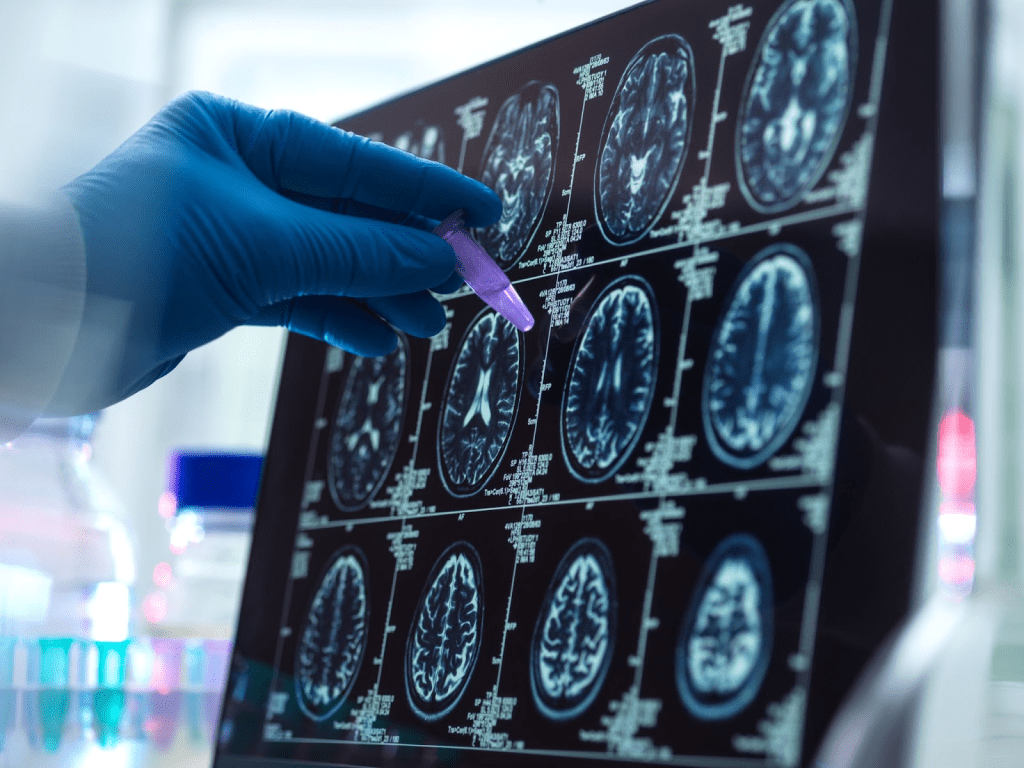This test uses a special camera and a radioactive substance, creating 3D pictures of the brain that make a SPECT brain scan worth it. Doctors use these images to find and track brain problems, making SPECT brain scans a key tool for diagnosis.
Key Takeaways
- SPECT scans provide 3D images of brain activity.
- They are used to diagnose and monitor neurological conditions.
- The test involves a radioactive substance and a special camera.
- SPECT scans offer valuable insights into brain function.
- Over 100,000 SPECT scans are performed annually in the US.
What is a SPECT Brain Scan?

The SPECT brain scan is a way to see how well different parts of the brain work. It uses a special kind of imaging called Single Photon Emission Computed Tomography. This method looks at blood flow and activity in the brain.
This tool is great for checking how the brain functions. It helps find areas that might not be working right. This can point to many neurological and psychiatric issues.
The Science Behind SPECT Imaging
SPECT imaging uses a tiny bit of radioactive tracer. This tracer is injected into the blood. As it moves, it sends out gamma rays that the SPECT camera catches.
These rays help make images that show brain activity and blood flow. This is key because many brain problems affect how it works. SPECT gives a functional view, not just a look at the brain’s structure.
How SPECT Differs from Other Brain Imaging Techniques
SPECT scans focus on how the brain works, unlike MRI, which looks at the brain’s structure. MRI shows the brain’s physical shape. But SPECT shows how different parts of the brain are active.
PET scans also look at brain function, but they cost more and use different tracers. Whether to use SPECT or PET depends on what you need to find out and what’s available.
| Imaging Technique | Primary Use | Key Characteristics |
| SPECT | Evaluating brain function and activity | Uses radioactive tracers to measure cerebral blood flow |
| MRI | Anatomical imaging of brain structures | Provides detailed structural images without radiation |
| PET | Assessing metabolic activity in the brain | Involves different tracers; generally more expensive than SPECT |
A medical expert says, “SPECT scans give us a special look at brain function. This is very important for diagnosing and treating brain disorders.” This shows how vital SPECT is in medical care.
The Process of Undergoing a SPECT Brain Scan
To have a smooth SPECT brain scan, patients need to know what to do before, during, and after. This includes preparation, the scan itself, and getting the results.
Before the Procedure: Preparation Requirements
Getting ready for a SPECT brain scan involves some steps. You might need to avoid certain medicines or foods. It’s key to follow what your healthcare provider or the imaging center tells you.
Some medicines might need to be stopped before the scan. You’ll also learn about any food restrictions. Knowing these helps make the scan a success.
During the Scan: What to Expect
During the SPECT scan, a special dye is injected into your blood. You’ll lie on a table while the SPECT machine takes pictures of your brain. This is painless and usually takes 30 minutes to an hour.
The brain perfusion SPECT method checks blood flow in the brain. It helps find and diagnose many neurological issues.
After the Scan: Recovery and Results
Right after the SPECT brain scan, you can go back to your usual activities. The results come in a few days. A specialist will interpret them.
Your healthcare provider will talk to you about the findings. Understanding these results is important for planning your next steps.
Brain SPECT Scan Diagnosis and Detection Capabilities
Brain SPECT scans give us a peek into how our brains work. They help find several brain and mental health issues. By looking at blood flow and brain activity, SPECT scans offer insights into brain function problems.
Neurological Disorders Detected by SPECT
SPECT scans are great for spotting and checking on brain and nerve problems. Here are some key conditions they can help with:
- Alzheimer’s disease: SPECT scans can tell Alzheimer’s apart from other dementias.
- Parkinson’s disease: SPECT imaging helps diagnose Parkinson’s and track its progress.
- Seizure disorders: SPECT scans find where seizures start, helping with epilepsy checks.
| Neurological Disorder | SPECT Scan Utility |
| Alzheimer’s disease | Differentiation from other dementias |
| Parkinson’s disease | Diagnosis and progression assessment |
| Seizure disorders | Identification of seizure foci |
Psychiatric Conditions Evaluated Through SPECT
SPECT scans also help with mental health issues. These include:
- Depression: SPECT helps measure how severe it is and guides treatment.
- Anxiety disorders: SPECT looks at brain activity to understand anxiety better.
- Attention Deficit Hyperactivity Disorder (ADHD): SPECT scans spot patterns linked to ADHD.
The data from SPECT scans is key for treating brain and mental health issues. It helps doctors understand brain function better. This leads to better treatment plans.
Clinical Applications of SPECT Brain Imaging
SPECT brain imaging is a key tool in clinics for checking and managing brain disorders. It shows detailed brain function and activity. This makes it very useful for diagnosing and treating many neurological and psychiatric issues.
Dementia and Alzheimer’s Disease Assessment
SPECT brain imaging is very important for checking dementia and Alzheimer’s disease. It looks at brain blood flow and activity patterns. It helps tell Alzheimer’s apart from other dementias, so doctors can plan better treatments.
- Identifying characteristic perfusion patterns in Alzheimer’s disease
- Differentiating Alzheimer’s from other dementias
- Monitoring disease progression and response to treatment
Traumatic Brain Injury Evaluation
SPECT imaging is also used for traumatic brain injuries (TBI). It shows how much brain damage there is and helps plan rehabilitation. It finds areas of brain activity that are lower because of the injury, helping doctors understand the injury’s severity.
- Assessing the extent of brain damage post-TBI
- Guiding rehabilitation strategies based on SPECT findings
- Monitoring recovery and possible long-term effects
Seizure Disorder Diagnosis
In diagnosing seizure disorders like epilepsy, SPECT brain imaging is very helpful. It finds where seizures start. SPECT helps plan surgeries or other treatments for seizures.
| Condition | SPECT Imaging Application |
| Dementia/Alzheimer’s | Assessing cerebral perfusion, identifying disease patterns |
| Traumatic Brain Injury | Evaluating extent of brain damage, guiding rehabilitation |
| Seizure Disorders | Localizing seizure foci, planning treatment |
SPECT brain imaging has many uses in clinics. It improves diagnosis and helps doctors make better treatment plans for many brain conditions.
Accuracy and Reliability of SPECT Brain Scans
It’s important to know how reliable SPECT brain scans are. These scans help doctors diagnose many neurological and psychiatric issues. They are key for deciding the best treatment.
Sensitivity and Specificity Rates
The accuracy of SPECT scans changes with each condition. For example, they are very good at spotting some types of dementia. But, they might sometimes show false positives, which means they might not always be right.
Nuclear medicine techniques like SPECT are great for showing how the brain works. They help find parts of the brain that are not active, which can point to many neurological problems. Researchers are always working to improve how well SPECT scans can diagnose these issues.
Limitations in Diagnostic Precision
SPECT brain scans give valuable insights but have some limits. The pictures from SPECT scans are not as clear as those from MRI. This makes it harder to spot some conditions. Also, only experts can really understand what the scans mean, and even then, there can be differences in how they interpret them.
In the world of nuclear medicine brain diagnosis, SPECT scans are good for checking brain blood flow and function. But, how well they work can depend on the quality of the equipment and the doctor’s experience.
Knowing both the strengths and weaknesses of SPECT brain scans helps doctors use them better. This approach is key to giving the best care and improving treatment results.
Cost-Benefit Analysis of SPECT Brain Imaging
Deciding on a SPECT brain scan means looking at its benefits and costs. SPECT brain imaging gives deep insights into brain function. It helps diagnose many neurological and psychiatric issues.
Average Costs and Insurance Coverage
The price of a SPECT brain scan changes based on location, facility, and scan details. Insurance coverage for SPECT scans varies too. It’s key to check with your insurance to see what’s covered.
Factors influencing the cost include:
- The complexity of the scan
- The facility’s charges
- Geographic location
Value Proposition: When the Benefits Outweigh Costs
SPECT brain imaging is valuable for accurate diagnoses and treatment plans. It helps with Alzheimer’s disease, traumatic brain injury, and seizure disorders. It spots brain spect scan abnormalities to guide treatments.
When other tests don’t work, SPECT brain imaging shines. It gives insights that can change treatment plans. This makes it a key tool in diagnosis.
Choosing to get a SPECT brain scan should consider its benefits and costs. Think about your medical needs and financial situation.
Controversies and Criticisms Surrounding SPECT Brain Scans
SPECT brain imaging has sparked scientific debates. It’s used to understand brain function but its usefulness is debated. This is true for neurological and psychiatric conditions.
Scientific Debates on Clinical Utility
The use of SPECT scans is a topic of debate. Some question its ability to detect certain conditions accurately. For example, its role in spotting early Alzheimer’s disease is a point of discussion.
Supporters say SPECT offers unique insights for diagnosis and treatment. Critics argue its resolution and specificity are not as good as other methods like MRI.
- SPECT’s ability to assess brain perfusion and function
- Its role in evaluating traumatic brain injury and seizure disorders
- The need for standardized protocols to improve diagnostic consistency
A Doctor, a well-known figure in SPECT imaging, says it provides unique insights. But he also stresses the importance of careful interpretation and matching with clinical symptoms.
“The future of SPECT imaging lies in its ability to be used in conjunction with other diagnostic tools to provide a more complete understanding of brain health.”
Ethical Considerations in Brain Imaging
There are ethical concerns with SPECT brain scans. One major worry is misdiagnosis or misinterpreting scan results. This can affect patient care and management.
There’s also concern about radiation exposure from SPECT scans. While doses are low, informed consent and patient education are key to addressing these issues.
- Ensuring patients understand SPECT scan benefits and limitations
- Using SPECT scans wisely, based on clinical needs
- Improving the technique to reduce risks and enhance benefits
In conclusion, SPECT brain scans provide valuable information but face controversies and criticisms. Ongoing research and debate are essential. They help ensure SPECT imaging is used effectively and responsibly.
Alternatives to SPECT Brain Scanning
SPECT brain scans are useful, but other imaging methods exist. Each has its own benefits and drawbacks. The right choice depends on the patient’s needs and the doctor’s goals.
Choosing an imaging method involves several factors. These include the suspected disorder, whether structural or functional info is needed, and what’s available. Knowing about SPECT alternatives helps doctors make better choices.
Comparing SPECT to MRI and CT Scans
MRI and CT scans are common alternatives to SPECT. MRI gives detailed structural images without radiation. It’s great for looking at brain anatomy.
CT scans are fast and easy to find, making them good for emergencies. They’re good for finding bleeding, fractures, and other structural issues. But, they do involve radiation, which is a concern for some patients.
MRI and CT scans have their own strengths. MRI is better for soft-tissue contrast and finding structural problems. CT scans are quicker and better for acute bleeding. SPECT is best for looking at brain function and blood flow.
Newer Brain Imaging Technologies
New brain imaging techs have come out, like fMRI. It shows brain activity by looking at blood flow. It’s great for mapping brain function and finding areas involved in tasks.
Techniques like DTI and MRS also exist. DTI looks at white matter and brain connections. MRS checks brain metabolism. These techs add to what SPECT can do, giving a fuller picture of the brain.
Choosing between these options depends on the situation. Knowing what each can do helps doctors pick the best one for their patients.
Conclusion: Is a SPECT Brain Scan Worth It for You?
Deciding on a SPECT brain scan depends on your personal situation and health needs. We’ve looked at the good and bad sides of SPECT scans in brain spect scan diagnosis and spect brain imaging diagnosis.
SPECT scans are good at finding problems in the brain. They help with brain spect diagnostic applications for brain and mental health issues. Knowing how SPECT scans work can help you decide if they’re right for you.
Think about the pros and cons of SPECT scans before making a choice. For some, the spect neurological diagnosis from SPECT scans is very helpful in planning treatment.
So, whether or not to get a SPECT brain scan is a big decision. It should be talked over with a doctor, considering your health and personal situation.
FAQ
What is a SPECT brain scan used for?
A SPECT brain scan checks how well the brain works. It helps find and manage brain and mental health issues. This includes conditions like dementia, brain injuries, and seizures.
How does a SPECT brain scan work?
A SPECT scan uses a tiny bit of radioactive material. It’s injected into the blood and goes to the brain. A camera then takes pictures of the brain, showing where it’s most active.
What is the difference between a SPECT scan and an MRI?
A SPECT scan looks at brain function, while an MRI shows brain structure. SPECT is great for checking how the brain works. MRI is better for looking at the brain’s shape.
Can a SPECT brain scan diagnose dementia?
Yes, a SPECT scan can spot dementia by looking at brain activity. It can tell if it’s Alzheimer’s or another type of dementia.
How accurate are SPECT brain scans?
SPECT scans are pretty reliable for some conditions. But, they’re not perfect. Their accuracy can vary based on the condition being checked.
What are the benefits of using SPECT brain imaging?
SPECT imaging is good for checking brain function and diagnosing conditions. It helps plan treatments. Plus, it’s not too invasive and can work with other scans.
Are there any risks or side effects associated with SPECT brain scans?
SPECT scans use a tiny bit of radiation, but the risks are low. Some might feel anxious or uncomfortable during the scan. These feelings usually go away quickly.
What are the alternatives to SPECT brain scanning?
Other options include MRI, CT scans, and PET scans. Newer tech like functional MRI and diffusion tensor imaging are also being used.
Can SPECT brain scans be used to evaluate traumatic brain injuries?
Yes, SPECT scans can check brain injuries. They look at brain function and find damaged areas.
How do SPECT brain scans contribute to treatment planning?
SPECT scans help plan treatments by showing brain function. This info helps doctors create specific plans for different brain and mental health issues.





